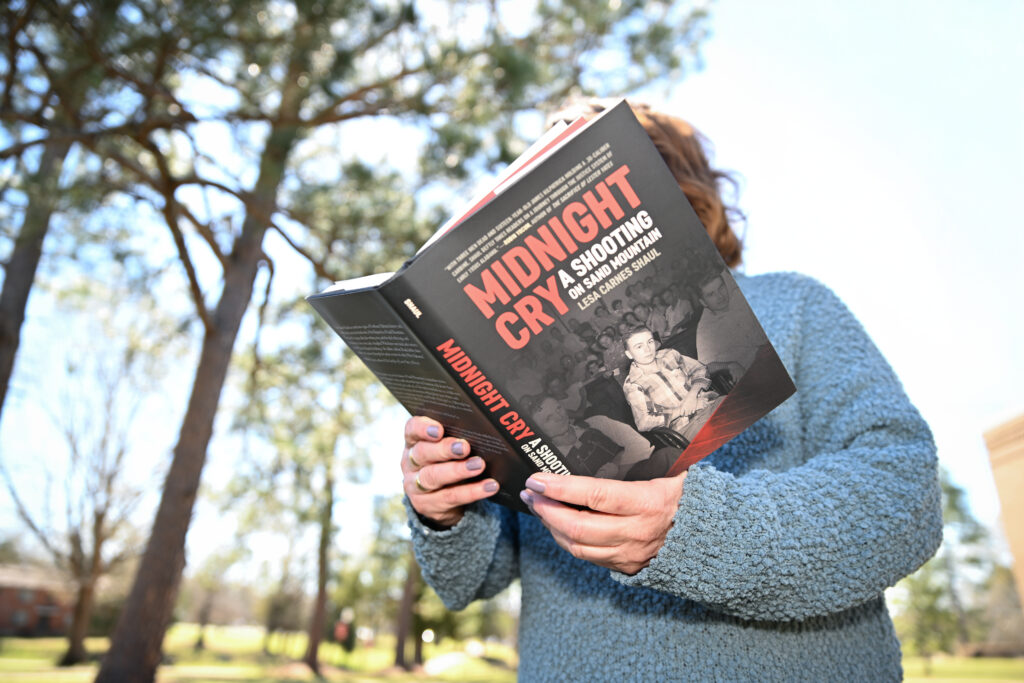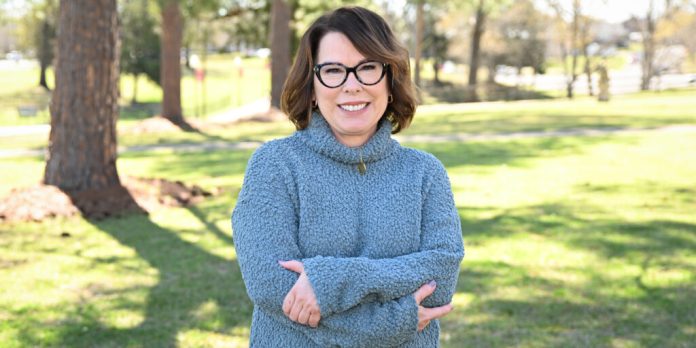LIVINGSTON — “Marshall County, Alabama, was too small for Aubrey Kilpatrick and Zeke Boyles to co-exist,” writes Lesa Carnes Shaul in her new book, “Midnight Cry: A Shooting on Sand Mountain.”
An English professor at the University of West Alabama specializing in American Literature, Shaul spent the first 18 years of her life on Sand Mountain, where she first heard about the story of the grievous event she would later explore in her book.
Distantly related to the Kilpatrick family, Shaul learned of the tragedy — known locally as the Kilpatrick shooting — from her parents, who were teenagers in the 1950s. The event stayed in her mind for decades, and she felt compelled to revisit it, describing “Midnight Cry” as her “love letter to home.”
When Shaul began writing the book in February 2021, she quickly realized that she wasn’t just chronicling the events leading up to the May 17, 1951, shooting. She was also exploring life in Alabama during that time, along with the mountain and river cultures that shaped the region.

Her main characters — Zeke Boyles, the sheriff of Marshall County and a businessman living in Guntersville at the base of Sand Mountain, and Aubrey Kilpatrick, a larger-than-life bootlegger with a 200-acre farm on the mountain — came to symbolize more than just the tragedy. They embodied a place and time, and their fates would become intertwined in a deadly confrontation that would shake the community to its core.
In the aftermath of the shooting, 16-year-old James Kilpatrick, Aubrey Kilpatrick’s oldest son, stood trial for the deaths of Sheriff Zeke Boyles, Boaz Chief of Police Leonard Floyd, and Chief Deputy Washington Bennett of Marshall County. On that same fateful night, Aubrey Kilpatrick also lost his life.
Shaul has some regrets about waiting so long before tackling her first non-academic book, mainly that her mother wasn’t alive to witness her accomplishment.
“My mom, who passed away in 2018, had been telling me since I was five years old that I needed to write a book,” she said.
“Midnight Cry” was never meant to be a dry, academic work. Shaul intended for it to be a compelling narrative that anyone — regardless of their background — could connect with.
“I didn’t want it to feel like a textbook,” she said. “I wanted it to be something people could read and enjoy.”
When the book was released in October 2024, Shaul embarked on a whirlwind tour, attending 11 events in just two weeks.
The first reading took place at the Boaz Legacy Museum, near the site of the shooting, where a packed house gathered. Although many in attendance hadn’t been alive when the shooting occurred, they had heard the story — just as Shaul had.
“People came because it was part of their family lore,” she said. “I met descendants of Leonard Floyd, Boaz Chief of Police, who wept openly, even though they had never met him.”
Their grief, Shaul said, underscored how deeply the past still lingered, woven into the very fabric of the community.
At another event, Shaul met Jettie Faye Kilpatrick, who was only three years old when her father, Aubrey, was killed.
Faye had been sent to the Talladega School for the Deaf at age six and had lived much of her life with the trauma of that night. 4When she met Faye, the only American sign language Shaul could remember was the gesture for “thank you.”
“I signed it to Faye, and she signed it back and hugged my neck,” Shaul said. “That moment of acceptance was profoundly moving.
“I was anxious. This was our first meeting, and though I didn’t interview Faye like I did many other Kilpatricks for the book, I wanted to get her story right. It’s her trauma, her childhood, and I needed to honor that.”
November and December brought more speaking events before things ramped up again in 2025. One of her most recent appearances was on the March 7 episode of “Most Notorious! A True Crime History Podcast,” (Episode 381: Alabama’s Kilpatrick Shooting with Erik Rivenes.
“It was a blast,” Shaul said, smiling. “Erik Rivenes, the host, gave me free rein to talk about the book, prompting me from time to time with really evocative questions. After chatting for more than two hours, he then edited all that conversation down into one smooth, consistently paced interview that I was very pleased with.”
Looking ahead, Shaul will be the featured speaker at the Readers and Writers Jubilee on June 14, in Decatur; a guest lecturer at the University of Alabama Law School in September; and will deliver the keynote address for the Alabama Historical Association at their Fall Pilgrimage meeting in October in Guntersville.
One of her favorite aspects of promoting the book has been the speaking engagements in small-town museums, libraries, historical associations, and independent bookstores.
“I like teaching,” she said. “I’ve been a college professor for almost my entire adult career, so I enjoy talking and teaching at these events.”
Like many professors, Shaul admits that she briefly considered a career as a lawyer.
“I never thought I could be a trial lawyer,” she said with a laugh. “But reading the trial transcripts while researching this book made me realize that lawyers, like writers, are all about building narratives and telling stories. And that’s what I do at UWA.”
In her courses, Shaul often emphasizes storytelling that speaks to both academic analysis and personal connection.
“I take an existing narrative, analyze each section, and look at what the different parts mean,” she said. Shaul also teaches her students how literature can connect to real lives and real histories, not just as an academic exercise.
For Shaul, writing “Midnight Cry” became an extension of her work as a professor,
“I mean, why live a life immersed in words and language if you’re not going to roll around in it a bit?” she said with a smile.
Recently, Shaul has been in discussions with high school teachers in Albertville, Boaz, and Guntersville, proposing that “Midnight Cry” become part of their schools’ reading curriculum. The response has been overwhelmingly positive.
“It’s local history, which is a big component, but I also think it’s because it’s a good book that raises questions we’re still pondering over today,” she said.
Although Shaul is not sure she can call writing her second career just yet, she is already researching her next project: a deep dive into the forensic investigation of the Kilpatrick shooting.
“I dedicated an entire chapter to the forensic investigation,” she said. “That was a rabbit hole that nearly derailed my first book. I had to pull back and focus on what I needed for “Midnight Cry,” but I knew then that I wanted to explore Dr. Carl Rehling, who was instrumental in founding and directing the Alabama Department of Forensic Sciences at Auburn University.”
Over his 40-year career as director of the ADFS, Rehling investigated — and often solved — some of the most notorious and shocking crimes in Alabama history.
“His story is fascinating,” Shaul said. “And I believe I can tell a compelling story about man who played a pivotal role in the investigation.”
As the 75th anniversary of the shooting draws near next year, the tragic events of that fateful night in 1951 continue to resonate.
“People are still talking about it,” Shaul said. “William Faulkner said, ‘The past isn’t dead.’ It certainly isn’t on Sand Mountain.”
Don’t miss out! Subscribe to our email newsletter to have all our smart stories delivered to your inbox.



